Gateway FPD2485W: 24" LCD Beauty or Beast?
by Jarred Walton on February 22, 2007 10:00 AM EST- Posted in
- Displays
Features and Appearance
We've already covered some of the features on the specifications page, but we're going to take a closer look at the display here and provide images from various angles. Assembling the display is extremely simple: after removing the three major pieces from the box (the display as well as the two parts of the base stand), you first attach the circular base to the mounting arm and lock it into place using the provided screw on the bottom of the stand. After that all you have to do is insert the top of the LCD mounting mechanism into the stand and then lower it until it snaps into place.
The base stand provides five inches of vertical travel, which gives you a reasonable amount of height adjustment. The stand also allows you to rotate the LCD and use it in portrait mode. While we can't say using a 24" LCD in portrait mode is something we found to be particularly useful, some people might feel otherwise. One of the great things about having such a large LCD is that it gives you the ability to view two documents (or document pages, web pages, etc.) side-by-side with room to spare, making portrait mode largely unnecessary.
With the display in portrait mode, you don't get quite as much vertical travel, and cable routing can be a bit trickier as well. The display supports auto rotate functionality, so as soon as you rotate the display Windows will automatically recognize the new orientation and change your resolution as appropriate. It is unlikely that this functionality works outside of Windows, due to a lack of native drivers for other operating systems, but we did not actually test this functionality outside of Windows; regardless, as stated already we don't find portrait mode to be particularly necessary on widescreen displays.
Here you can see a shot of the display with the optional speaker bar installed. The speaker bar attaches to the bottom of the LCD and receives power via a short cable that connects to the rear of the main display. The speakers only support stereo audio inputs (standard 1/8" DIN or RCA jacks), but they can try to emulate 3D surround sound if you'd like and the overall quality is pretty good given their size. There are plenty of better sounding speaker options available for $70 or less, but one nice benefit of the attached speaker bar is that you get reasonable quality audio without taking up much desk space. If you're more concerned with eliminating cable clutter than with getting premium quality audio, we would definitely add the speaker bar to a purchase of this display. The speakers also have the potential disadvantage of making portrait mode more difficult to access, so if you do intend to use the portrait mode we would forgo purchasing the speaker attachment.
Here you can see the rear of the unit, with or without the speaker bar. The back of the base stand also includes a small ring that can be used to aid in cable routing. If you would rather do without the base stand, you can of course remove the mounting bracket and use a standard VESA wall mount instead.
All of the input ports are located on the back of the unit, facing downward. One of the advantages of being able to rotate the display is that it makes it easier to install the cables initially. The only ports not located on the bottom of the display are two additional USB ports which are located on the left side. The ability to have the display function as a USB hub can be useful, although personally we prefer the integrated flash memory readers found on competing Dell LCDs. Flash memory readers are cheap, but integrating them into the display is one more way of eliminating cable clutter. If you have a flash reader integrated into your PC, of course, having a second reader on your display is largely superfluous.
We've already covered some of the features on the specifications page, but we're going to take a closer look at the display here and provide images from various angles. Assembling the display is extremely simple: after removing the three major pieces from the box (the display as well as the two parts of the base stand), you first attach the circular base to the mounting arm and lock it into place using the provided screw on the bottom of the stand. After that all you have to do is insert the top of the LCD mounting mechanism into the stand and then lower it until it snaps into place.
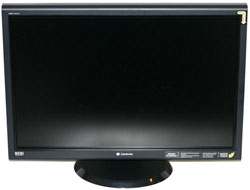 |
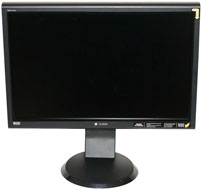 |
| Click to enlarge | |
The base stand provides five inches of vertical travel, which gives you a reasonable amount of height adjustment. The stand also allows you to rotate the LCD and use it in portrait mode. While we can't say using a 24" LCD in portrait mode is something we found to be particularly useful, some people might feel otherwise. One of the great things about having such a large LCD is that it gives you the ability to view two documents (or document pages, web pages, etc.) side-by-side with room to spare, making portrait mode largely unnecessary.
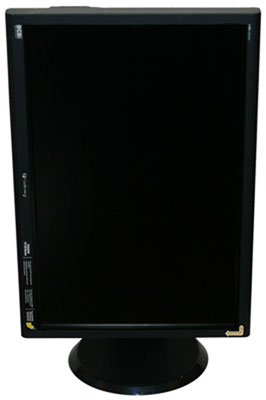 |
| Click to enlarge |
With the display in portrait mode, you don't get quite as much vertical travel, and cable routing can be a bit trickier as well. The display supports auto rotate functionality, so as soon as you rotate the display Windows will automatically recognize the new orientation and change your resolution as appropriate. It is unlikely that this functionality works outside of Windows, due to a lack of native drivers for other operating systems, but we did not actually test this functionality outside of Windows; regardless, as stated already we don't find portrait mode to be particularly necessary on widescreen displays.
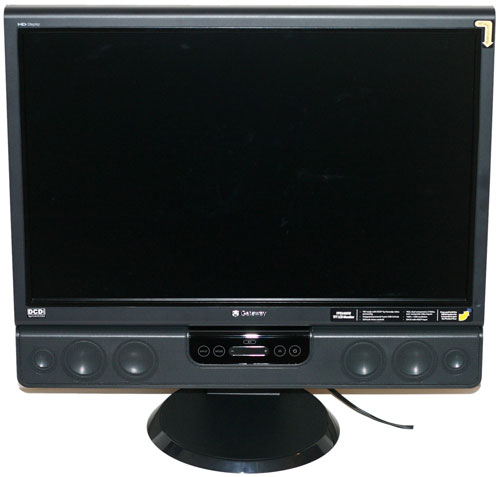 |
| Click to enlarge |
Here you can see a shot of the display with the optional speaker bar installed. The speaker bar attaches to the bottom of the LCD and receives power via a short cable that connects to the rear of the main display. The speakers only support stereo audio inputs (standard 1/8" DIN or RCA jacks), but they can try to emulate 3D surround sound if you'd like and the overall quality is pretty good given their size. There are plenty of better sounding speaker options available for $70 or less, but one nice benefit of the attached speaker bar is that you get reasonable quality audio without taking up much desk space. If you're more concerned with eliminating cable clutter than with getting premium quality audio, we would definitely add the speaker bar to a purchase of this display. The speakers also have the potential disadvantage of making portrait mode more difficult to access, so if you do intend to use the portrait mode we would forgo purchasing the speaker attachment.
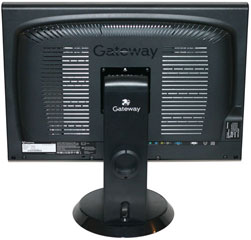 |
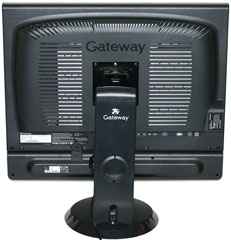 |
| Click to enlarge | |
Here you can see the rear of the unit, with or without the speaker bar. The back of the base stand also includes a small ring that can be used to aid in cable routing. If you would rather do without the base stand, you can of course remove the mounting bracket and use a standard VESA wall mount instead.
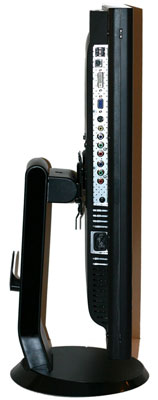 |
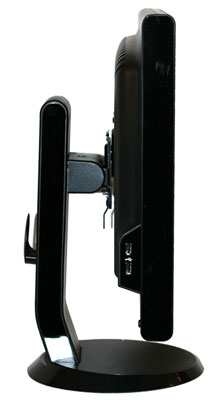 |
| Click to enlarge | |
All of the input ports are located on the back of the unit, facing downward. One of the advantages of being able to rotate the display is that it makes it easier to install the cables initially. The only ports not located on the bottom of the display are two additional USB ports which are located on the left side. The ability to have the display function as a USB hub can be useful, although personally we prefer the integrated flash memory readers found on competing Dell LCDs. Flash memory readers are cheap, but integrating them into the display is one more way of eliminating cable clutter. If you have a flash reader integrated into your PC, of course, having a second reader on your display is largely superfluous.










77 Comments
View All Comments
strikeback03 - Monday, February 26, 2007 - link
thanks, that makes sense. I assumed the LUT was applied to everything the video card sent to the monitor. However playing with my calibration settings in the GretagMacbeth software and also with the nVidia controls provided in their settings package did not touch the video image.My current desktop monitor absolutely destroys blacks in it's out-of-the-box configuration. Calibration can make most stuff OK (not great) but since it does not affect video, movies such as the Matrix or V for Vendetta are unwatchable.
JarredWalton - Thursday, February 22, 2007 - link
I didn't notice any issues with blacks being "crushed", but there were some other issues I'll address shortly in regards to colors.chizow - Thursday, February 22, 2007 - link
Crushed blacks are a pretty bad problem with miscalibrated displays. Basically if you use the provided calibration software EzTune and calibrate the display based on what the captions tell you, you'll get an overly dark setting with really high relative contrast. In games and movies, the result is horribly crushed blacks with no detail/difference in blacks and brain-searing light/particle effects. For instance, in Dark Messiah, I felt like I was running around with a blindfold on...except for the blinding light coming off my Lightning Shield, which I avoided using at all costs.Justin Case - Friday, February 23, 2007 - link
Note that most lossy video compression algorithms will eliminate more detail from very dark (or very bright) colors than from midtones, so if a DVD appears to have crushed blacks, that could be just a poor encode.Most 3D games have a local gamma setting, so a wrong value there can also make things look bad.
Having said that, poor loss of detail and posterization in dark areas is a problem with some LCD panels.
Justin Case - Thursday, February 22, 2007 - link
Laptop panels are typically picked for their low power consumption, not color accuracy, which makes those values a bit odd. What model is your laptop? And have you measured other monitors with the same calibrator?Anyway, simple calibrators won't measure things like color variation with angle of view, light bleed, etc. (which aren't issues for CRTs, but are for LCDs), so the deviation alone isn't a complete measure of the overall image quality.
strikeback03 - Friday, February 23, 2007 - link
Thinkpad T43 with the Flexview (IPS) screen. There is some slight contrast change with viewing angle, but it's the best I have seen in a laptop. Other displays I have checked include my desktop LCD (cheap, with predictably bad colors, which is why I'm looking to replace it), a cheap old CRT (not very good), and a few ViewSonic CRTs at work (good results from calibration on all).JarredWalton - Friday, February 23, 2007 - link
You should see the results from an older laptop I have. Even calibrated, dE is still a whopping 7.8! There are a few colors (blue and yellow I think) where I couldn't get dE to anything lower than 16-20. Heh. If you've got a display on a laptop that can get an average dE of anything less than 2.0, you're doing *VERY* well! My future laptop reviews will take a closer look at the laptop LCD quality....StevenG - Thursday, February 22, 2007 - link
Some sites have reported extensively on the issue of input lag with LCDs. They have found that if you drive a CRT and an LCD at the same time, the image on the LCD will often lag the CRT by 1 or more frames. So what you are seeing on screen with an LCD is actually up to 50 or so ms behind the image that is being produced by the video card. This is one reason why I still don't use LCDs for gaming (the other reason being low refresh rates, which means a low frames/second limit if you enable vsynch - I refresh at 100 Hz at 1280x1024 on my 21" CRT, and there isn't an LCD on the market that can match that).I would like to see Anandtech explore this issue of LCD lag.
Justin Case - Thursday, February 22, 2007 - link
You have a 5:4 aspect ratio CRT? If not, you should be using 1280x960. If you pick 1280x1024, most games will assume you're using a 5:4 monitor (LCD), and the image will be slightly distorted (vertically compressed).JarredWalton - Thursday, February 22, 2007 - link
Refresh rates are one of the advantages of CRTs that nothing else is currently able to match, unfortunately. I wish we could get 100 Hz refresh rates on LCDs, if only to avoid reduce the appearance of screen tear with vsync disabled, but the digital connection precludes that option for now.As for input lag, the pixel response times can make the LCD always appear one frame behind what is supposed to be shown, i.e. the GPU sends frame 1, and then 1/60 of a second later it sends frame 2, etc. The LCD receives frame one and the pixels start to transition, but the transition takes anywhere from 2-20ms (depending on colors and LCD). If we just say it takes ~16ms, that's one screen refresh. I've heard other LCDs may buffer input so that there's an additional lag, but if so I can't say that my eyes are sharp enough to detect it.